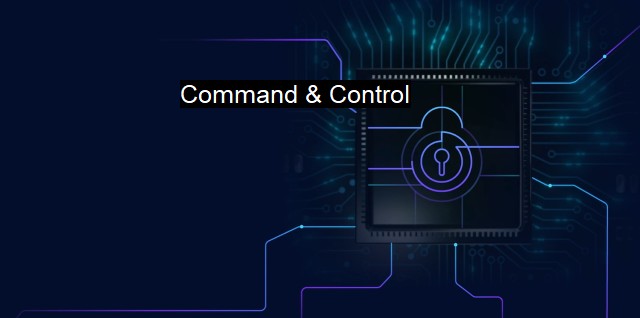What is Command & Control?
Unveiling the Structure of Command and Control (C&C) Systems in Cybersecurity and Antivirus: Exploring the Framework, Server, and Communication Components for Botnet Attacks
"Command & Control" (C&C or C2) is a term frequently referred to in discussions on cybersecurity, particularly concerning the operation and management of antivirus systems. It is a technique used by cyber threat actors to maintain communication with compromised systems within a target network.Understood fundamentally as an instruction-based system, C2 offers threat actors complete reign over victim networks, machines, or infrastructure. The remote command and control servers send directives to the affected systems with the help-or, more accurately, the enslavement-of Trojan software that allows remote access to the infected computer. With this, the infected system is forced into a bot (a compromised system) that is added to a larger network of affected hosts known as a botnet.
In the grand theatre of cybersecurity, botnets hold the veritable role of puppeteer in these malicious strings operation– guiding, directing, commandeering the organized tasks of scams, thefts, and blackmail malware within defenseless computers. With this vast orchestration comes a dizzyingly wide range of applications for Command and Control, from botnets launching Distributed Denial-of-Service (DDoS) attack to ransomware targeting vital systems for moneymaking, or even using the victim’s computer computational resources for crypto mining activities.
Cyber criminals employ command and control systems to control malware implanted in a targeted device clandestinely. Their nefarious operations can extend to executing malicious commands, extracting sensitive data, or propagating the malware to try to compromise yet more machines. these criminals have been getting progressively sophisticated due to the flourishing advancement of technology. Advanced Persistent Threats (APTs), or the advanced malignancy from external sources that extends over prolonged periods, underline this evolution.
Owing to their effectiveness, command and control networks can be hard to dismantle. A successful identification or takedown of one server does not stop the operation due to the network's decentralized nature. If one hub is taken apart, another springs into action, thus sustaining the botnet.
Guarding against such threats requires the use of advanced antivirus and cybersecurity solutions. These solutions work by flagging certain behaviours used in common command-and-control attacks, proactive defence protocol and decimating the infection to cease the communication between the controlled device and the C2 server.
First and foremost noteworthy are the Intrusion Prevention Systems (IPS) and Intrusion Detection Systems (IDS). These are the equivalent of fortress walls creating defensive layers around primary information systems. Alternatively, there are advanced threat detection and analytics tools that utilize complex algorithms capable of sifting through torrents of data piles. The goal of these tools is to find irregular patterns that can signal a potential breach or malware infection.
OAuth (Open Authorization), spam filters and updated antivirus software provide subsequent layers of protection. They diligently offer access tokens instead of user credentials and foil commonly known malware, respectively. virtualization systems are applied to sequester and study the behavior of potential risks loitering in the cyberspace—a sort of cyber pest quarantine system.
As technology advances, smarter, stronger, and sharper ways are ideated to battle cyber threats, yet the threats also escalate, keeping the entire cybersecurity community on their toes. Safeguarding against command-and-control schemes verily lies at the neurotic center of any cybersecurity plan and strategy. Recognizing this ever-dangerous practice is the first step in this continuously tested and ever-lasting commitment to cybersecurity.
-Unawareness is no defence, and against such threats, everyone must fortify their cyber barricades, and constant vigilance is key.

Command & Control FAQs
What is command and control in the context of cybersecurity?
Command and control refers to a type of attack in which a hacker gains control over a victim's computer or network through malicious software. The attacker can then issue commands to the compromised system, such as transmitting data or executing additional malware.What is the purpose of command and control in a cyber attack?
The purpose of command and control in a cyber attack is to enable the attacker to carry out various malicious activities, such as stealing sensitive data, launching DDoS attacks, or spreading malware. By gaining control over a victim's system, the attacker can easily execute their objectives without being detected.How can antivirus software detect and prevent command and control attacks?
Antivirus software can detect command and control attacks by looking for suspicious network traffic or communication between a compromised system and a remote server. Once detected, the antivirus software can prevent the attack by blocking the malicious traffic or isolating the affected system.What are some best practices for defending against command and control attacks?
To defend against command and control attacks, it's crucial to keep your antivirus software up to date, regularly patch your systems and software, limit access to sensitive information, and train employees on how to recognize and report suspicious activity. Additionally, implementing network segmentation, intrusion detection systems, and security information and event management (SIEM) technologies can also help detect and prevent command and control attacks.| | A | | | B | | | C | | | D | | | E | | | F | | | G | | | H | | | I | | | J | | | K | | | L | | | M | |
| | N | | | O | | | P | | | Q | | | R | | | S | | | T | | | U | | | V | | | W | | | X | | | Y | | | Z | |
| | 1 | | | 2 | | | 3 | | | 4 | | | 7 | | | 8 | | |||||||